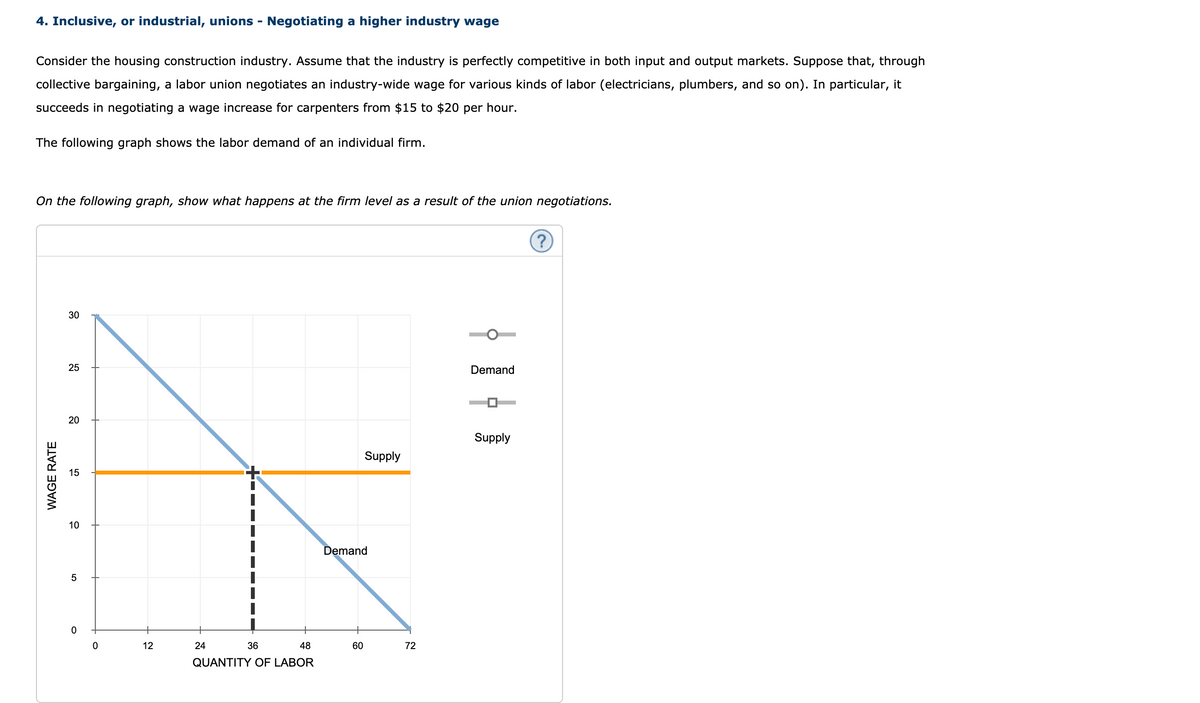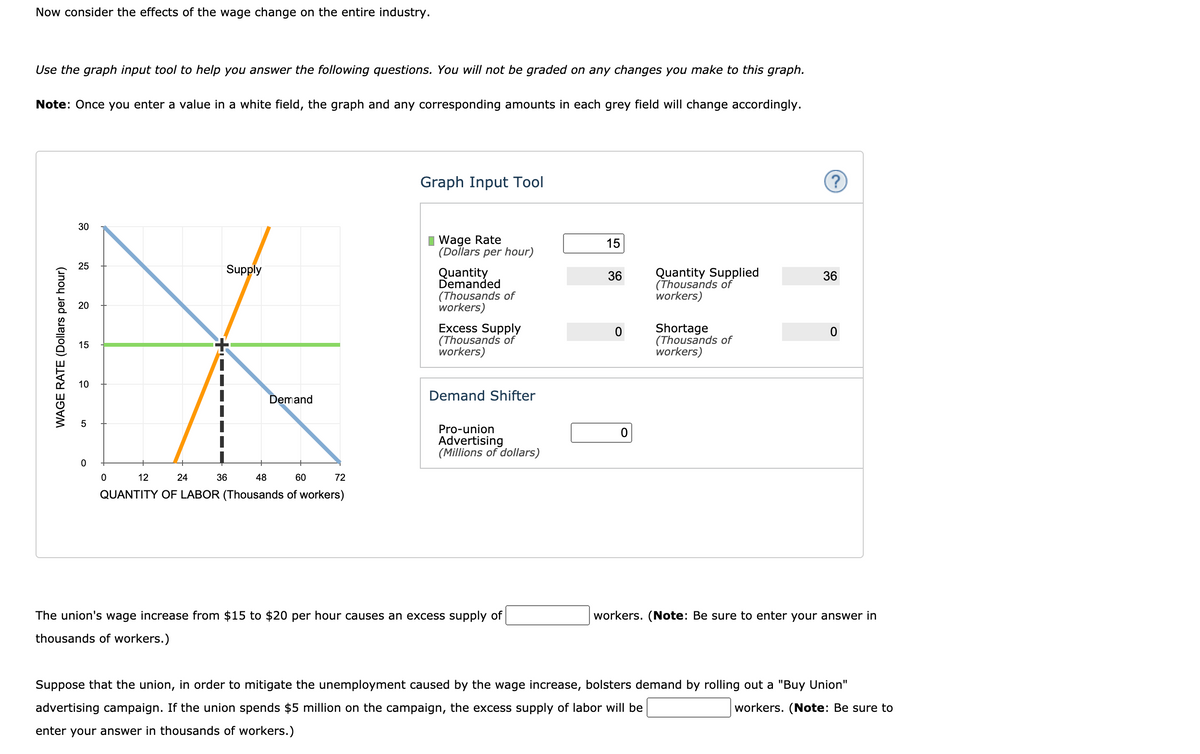4. Inclusive, or industrial, unions - Negotiating a higher industry wage Consider the housing construction industry. Assume that the industry is perfectly competitive in both input and output markets. Suppose that, through collective bargaining, a labor union negotiates an industry-wide wage for various kinds of labor (electricians, plumbers, and so on). In particular, it succeeds in negotiating a wage increase for carpenters from $15 to $20 per hour. The following graph shows the labor demand of an individual firm. On the following graph, show what happens at the firm level as a result of the union negotiations. (? 30 25 Demand 20 Supply Supply 10 Demand 12 24 36 48 60 72 QUANTITY OF LABOR WAGE RATE
4. Inclusive, or industrial, unions - Negotiating a higher industry wage Consider the housing construction industry. Assume that the industry is perfectly competitive in both input and output markets. Suppose that, through collective bargaining, a labor union negotiates an industry-wide wage for various kinds of labor (electricians, plumbers, and so on). In particular, it succeeds in negotiating a wage increase for carpenters from $15 to $20 per hour. The following graph shows the labor demand of an individual firm. On the following graph, show what happens at the firm level as a result of the union negotiations. (? 30 25 Demand 20 Supply Supply 10 Demand 12 24 36 48 60 72 QUANTITY OF LABOR WAGE RATE
Principles of Economics 2e
2nd Edition
ISBN:9781947172364
Author:Steven A. Greenlaw; David Shapiro
Publisher:Steven A. Greenlaw; David Shapiro
Chapter14: Labor Markets And Income
Section: Chapter Questions
Problem 1SCQ: Table 14.10 shows levels of employment (Labor), the marginal product at each of those levels, and...
Related questions
Question

Transcribed Image Text:4. Inclusive, or industrial, unions - Negotiating a higher industry wage
Consider the housing construction industry. Assume that the industry is perfectly competitive in both input and output markets. Suppose that, through
collective bargaining, a labor union negotiates an industry-wide wage for various kinds of labor (electricians, plumbers, and so on). In particular, it
succeeds in negotiating a wage increase for carpenters from $15 to $20 per hour.
The following graph shows the labor demand of an individual firm.
On the following graph, show what happens at the firm level as a result of the union negotiations.
(?
30
25
Demand
Supply
Supply
15
10
Demand
5
12
24
36
48
60
72
QUANTITY OF LABOR
WAGE RATE
20

Transcribed Image Text:Now consider the effects of the wage change on the entire industry.
Use the graph input tool to help you answer the following questions. You will not be graded on any changes you make to this graph.
Note: Once you enter a value in a white field, the graph and any corresponding amounts in each grey field will change accordingly.
Graph Input Tool
?)
30
I Wage Rate
(Dollars per hour)
15
25
Supply
Quantity
Demanded
(Thousands of
workers)
Quantity Supplied
(Thousands of
workers)
36
36
20
Excess Supply
(Thousands of
workers)
Shortage
(Thousands of
workers)
15
10
Demand
Demand Shifter
Pro-union
Advertising
(Millions of dollars)
12
24
36
48
60
72
QUANTITY OF LABOR (Thousands of workers)
The union's wage increase from $15 to $20 per hour causes an excess supply of
workers. (Note: Be sure to enter your answer in
thousands of workers.)
Suppose that the union, in order to mitigate the unemployment caused by the wage increase, bolsters demand by rolling out a "Buy Union"
advertising campaign. If the union spends $5 million on the campaign, the excess supply of labor will be
workers. (Note: Be sure to
enter your answer in thousands of workers.)
WAGE RATE (Dollars per hour)
Expert Solution
This question has been solved!
Explore an expertly crafted, step-by-step solution for a thorough understanding of key concepts.
This is a popular solution!
Trending now
This is a popular solution!
Step by step
Solved in 2 steps with 2 images

Knowledge Booster
Learn more about
Need a deep-dive on the concept behind this application? Look no further. Learn more about this topic, economics and related others by exploring similar questions and additional content below.Recommended textbooks for you

Principles of Economics 2e
Economics
ISBN:
9781947172364
Author:
Steven A. Greenlaw; David Shapiro
Publisher:
OpenStax

Brief Principles of Macroeconomics (MindTap Cours…
Economics
ISBN:
9781337091985
Author:
N. Gregory Mankiw
Publisher:
Cengage Learning

Economics: Private and Public Choice (MindTap Cou…
Economics
ISBN:
9781305506725
Author:
James D. Gwartney, Richard L. Stroup, Russell S. Sobel, David A. Macpherson
Publisher:
Cengage Learning

Principles of Economics 2e
Economics
ISBN:
9781947172364
Author:
Steven A. Greenlaw; David Shapiro
Publisher:
OpenStax

Brief Principles of Macroeconomics (MindTap Cours…
Economics
ISBN:
9781337091985
Author:
N. Gregory Mankiw
Publisher:
Cengage Learning

Economics: Private and Public Choice (MindTap Cou…
Economics
ISBN:
9781305506725
Author:
James D. Gwartney, Richard L. Stroup, Russell S. Sobel, David A. Macpherson
Publisher:
Cengage Learning

Microeconomics: Private and Public Choice (MindTa…
Economics
ISBN:
9781305506893
Author:
James D. Gwartney, Richard L. Stroup, Russell S. Sobel, David A. Macpherson
Publisher:
Cengage Learning
